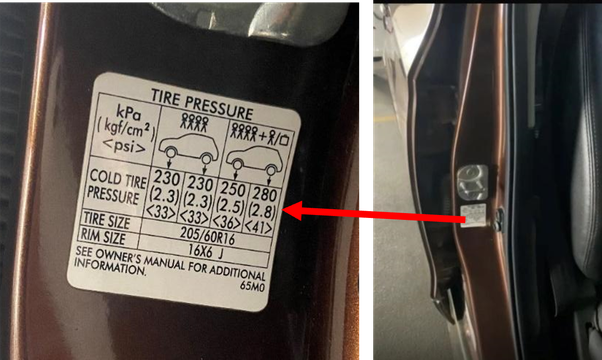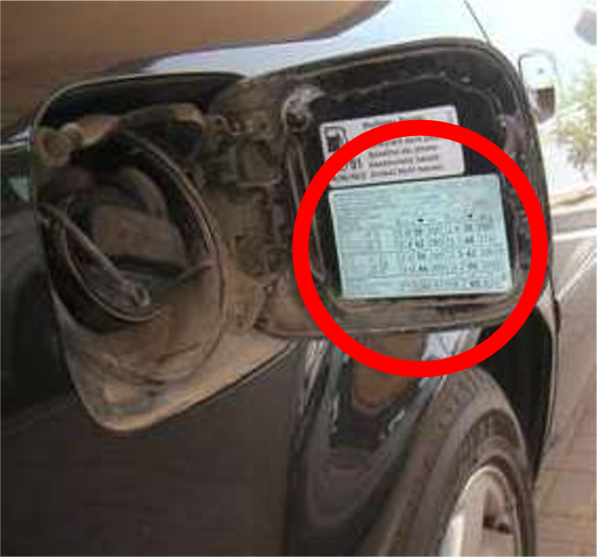Ever felt that subtle vibration in the steering wheel or noticed your car dragging slightly on the road? It’s easy to blame the traffic, the terrain, or even the vehicle itself. However, often the reason can be incorrect tyre pressure.
In India, where driving conditions shift dramatically from potholed city lanes to smooth expressways and winding mountain roads, maintaining the correct tyre pressure is not just good practice, but essential for safety, efficiency, and peace of mind.
So, if you’ve ever found yourself wondering how much pressure in car tyres is truly ideal, you’re not alone. Let’s find out the answers and why getting this right could make all the difference on your next drive.
Why is Tyre Pressure So Important?

Disclaimer: Images (s) shown are for illustrative purposes only. Actual product specifications, including tyre size and design, may vary.
Maintaining the correct tyre pressure is crucial as it affects key aspects like steering control, braking efficiency, fuel consumption, tyre wear, and overall road safety. With the correct pressure, you enjoy:
- Better fuel efficiency
- Smoother handling and braking
- Longer tyre life
- Good riding comfort
- Enhanced road safety
Quick Tip: Check your tyre pressure every two weeks or before any long road trip, especially in India, where the climate and road conditions vary drastically.
How Much Air Pressure in Car Tyres is Ideal?

Disclaimer: Images (s) shown are for illustrative purposes only. Actual product specifications, including tyre size and design, may vary.
Now that we know the importance of tyre pressure, let’s learn how much air pressure is needed in a car tyre. Your car tyre ideal pressure depends on:
- The car make and model
- Tyre size
- Number of passengers with luggage, etc.
You can find the recommended PSI for your car in the owner’s manual, driver-side door sticker, or fuel lid. Sticking to these values ensures optimum tyre performance and overall safety.
Understanding the Decrease in Tyre Pressure


Disclaimer: Images (s) shown are for illustrative purposes only. Actual product specifications, including tyre size and design, may vary.
Let us start with understanding why does the pressure in tyre decrease over time, even if the vehicle is not driven? Just like an inflated balloon loses air over few days, tyres also lose pressure over time, even if they don’t have any puncture or air leakage.
Air molecules are tiny and will always find a way out through the body. Apart from the natural permeability from the rubber, air can leak due to other reasons like puncture, damaged valve, and even if the bead surface and rim flange are rusted, deformed or damaged. So, it is important to check air pressure on regular intervals. It is recommended to check car tyre pressure once in every two weeks or before long trips.
Below are the recommendations regarding tyre pressure maintenance:
- Always maintain tyre pressure recommended by the vehicle manufacturer.
- Tyre Pressure should be checked when the tyres are in cold condition (ambient temperature) for an accurate reading.
- Use Proper calibrated pressure gauge.
- Use Valve caps to protect the valve core from damage due to dust or water.
- Use of Nitrogen decreases the number of air refills or top-ups.
- Don’t forget to check the air pressure of the spare tyre, once in a while.
Common Mistakes to Avoid with Tyre Pressure
Let's further move on to the mistakes to avoid. It’s not just about knowing how much air should be in a car tyre, but also about avoiding common slip-ups:
- Ignoring the spare tyre Many drivers forget to check the spare, which can be underinflated when needed most.
- Skipping pressure checks during temperature changes Tyre pressure drops in cold weather and rises in heat. Seasonal checks are essential.
- Relying on visual inspection instead of a pressure gauge Relying on visual inspection alone can be misleading, as tyres may appear properly inflated while actually being either underinflated or overinflated, so always use a calibrated pressure gauge for accurate measurement.
- Forgetting that PSI increases as tyres heat up during driving Always check tyre pressure when tyres are cold (before driving), as heat can give a false high reading.
What Happens If You Drive With Incorrect Tyre Pressure?
Once we are done learning the common mistakes, let’s find out what happens if you drive with inappropriate tyre pressure. Driving with incorrect tyre pressure isn’t just bad for your tyres, it can have serious consequences for your vehicle’s performance, fuel economy, and most importantly, your safety.

Disclaimer: Images (s) shown are for illustrative purposes only. Actual product specifications, including tyre size and design, may vary.
Underinflated Tyres
When tyres are underinflated, they don’t maintain their intended shape. This causes the sidewalls and edges to flex more than necessary, leading to:
- Faster wear along the outer edges (both side shoulder wear), shortening tyre life.
- Increased rolling resistance, which forces your engine to work harder, consumes more fuel.
- Poor handling and braking, especially in wet conditions, increases the risk of hydroplaning which may cause accidents.
- Excessive heat build-up, which may cause tyre blowouts during long or high-speed drives.
- Underinflation (low or zero inflation pressure) can lead to runflat damage in tyre.
Overinflated Tyres
On the other hand, overinflated tyres become too rigid, reducing their ability to absorb road shocks and vibrations. This leads to:
- Excessive wear in the centre of the tread (centre wear) reduces lifespan.
- Decreased road contact can affect traction, grip and cornering stability.
- A harsher ride, especially on rough or uneven roads.
- Greater risk of tyre damage from potholes and road debris (punctures, etc.).
Take Control of Your Drive
Now that you know how much pressure in car tyres makes a difference, don’t leave it to guesswork. Make regular checks part of your car care routine. It’s one of the easiest and most effective ways to boost safety, extend tyre life, and improve your overall drive quality.
Disclaimer:The information provided is for general guidance only. The author assumes no responsibility for errors or omissions, or for any consequences resulting from the use of this information.
